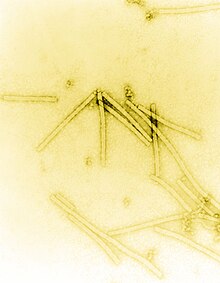Tobamovirus
| Tobamovirus | |
|---|---|
 |
|
| Electron micrograph of Tobacco mosaic virus particles at 160,000x magnification | |
| Virus classification | |
| Group: | Group IV ((+)ssRNA) |
| Family: | Virgaviridae |
| Genus: | Tobamovirus |
| Type species | |
|
Tobacco mosaic virus |
|
Tobamovirus is a genus in the virus family Virgaviridae. Many plants, including tobacco, potato, tomato, and squash, serve as natural hosts. There are currently 35 species in this genus including the type species Tobacco mosaic virus. Diseases associated with this genus include: necrotic lesions on leaves. The name Tobamovirus is an acronym, coming from the host and symptoms of the first virus discovered (Tobacco mosaic virus).
There are four informal subgroups within this genus: these are the tobamoviruses that infect the brassicas, the cucurbits, and malvaceous and solanaceous plants. The main differences between these groups are genome sequences, and respective range of host plants.
These viruses are thought to have codiverged with their hosts from a common ancestor. There are at least 3 distinct clades of tobamoviruses, which to some extent follow their host ranges: that is, there is one infecting solanaceous species; a second infecting cucurbits and legumes and a third infecting the crucifers.
The RNA genome encodes at least four polypeptides: these are the non-structural protein and the read-through product which are involved in virus replication (RNA-dependent RNA polymerase, RdRp); the movement protein (MP) which is necessary for the virus to move between cells and the coat protein (CP). The read-through portion of the RdRp may be expressed as a separate protein in TMV. The virus is able to replicate without the movement or coat proteins, but the other two are essential. The non-structural protein has domains suggesting it is involved in RNA capping and the read-through product has a motif for an RNA polymerase. The movement proteins are made very early in the infection cycle and localized to the plasmodesmata, they are probably involved in host specificity as they are believed to interact with some host cell factors.
...
Wikipedia
